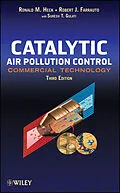Catalytic Air Pollution Control: Commercial Technology is the primary source for commercial catalytic air pollution control technology, offering engineers a comprehensive account of all modern catalytic technology. This Third Edition covers all the new advances in technology in automotive catalyst control technology, diesel engine catalyst control technology, small engine catalyst control technology, and alternate sustainable fuels for auto and diesel.
Autorentext
Ronald M. Heck, PHD, is President of RMH Consulting, where he specializes in consultation on environmental catalysis for auto, diesel, and stationary sources; general catalysis; fuel cells; reaction engineering; combustion technology; and chemical engineering. Previously, Dr. Heck was a Research Manager responsible for developing new catalyst technology for Engelhard Corporation's worldwide customers in environmental catalysis.
Robert J. Farrauto, PHD, is a Research Fellow at BASF Catalysts and Adjunct Professor in the Earth and Environmental Engineering Department of Columbia University in the City of New York, where he teaches courses in catalysis and supervises graduate student research. His responsibilities at BASF Catalysts include the development of advanced catalysts for the hydrogen economy. He has worked extensively in the development of catalysts for the environmental, petroleum, and chemical industries.
Suresh T. Gulati, PHD, is a Consultant to the Science and Technology Division of Corning. He has also been a research fellow with Corning, specializing in the behavior of brittle materials. Dr. Gulati has many years of experience working with automotive substrates, with an emphasis on their design and durability for diesel and passenger car applications.
Klappentext
The chemistry of superacids deals with acid systems stronger than conventional strong mineral Bronsted acids such as sulfuric acid and Lewis acids such as aluminum trichloride. The first edition of Superacid Chemistry, published in 1985, quickly became the definitive work in the field. Since that time, however, the field has grown exponentially, with the development of new superacid systems and innovative superacid applications. This Second Edition of Superacid Chemistry has been published to bring the acclaimed book fully up to date with all these new developments.
Superacid Chemistry features a team of pioneering authors in the field headed by George Olah, the 1994 Nobel Laureate in Chemistry. The book covers:
- General aspects of superacid chemistry, including types of superacids and experimental techniques for acidity measurements
- Superacid systems, including primary, binary, ternary, and solid superacids
- Carbocations in superacids, including methods of generating carbocations in superacids and methods and techniques in the study of carbocations
- Heterocations in superacids, including onium ions, enium ions, homo-,and heteropolyatomic cations, and cations of group 6-12 elements
- Superacid catalyzed reactions, including conversion of saturated hydrocarbons and alkylation of aromatic hydrocarbons
Extensive references are provided throughout the book to guide readers to the primary literature for further in-depth investigations. In short, this Second Edition meets the growing need for current information on superacid chemistry among researchers in inorganic, organic, and physical chemistry in order to support and advance their research.
Inhalt
Preface xiii
Acknowledgments xvii
Acknowledgments, First Edition xix
Acknowledgments, Second Edition xxi
I Fundamentals 1
1. Catalyst Fundamentals 3
1.1 Introduction 3
1.2 Catalyzed Versus Noncatalyzed Reactions 3
1.3 Catalytic Components 13
1.4 Selectivity 14
1.5 Promoters and their Effect on Activity and Selectivity 15
1.6 Dispersed Model for Catalytic Component on Carrier: Pt on Al2O3 16
1.7 Chemical and Physical Steps in Heterogeneous Catalysis 18
1.8 Practical Significance of Knowing the Rate-Limiting Step 21
References 22
Questions 23
2. The Preparation of Catalytic Materials: Carriers, Active Components, and Monolithic Substrates 24
2.1 Introduction 24
2.2 Carriers 24
2.3 Making the Finished Catalyst 30
2.4 Nomenclature for Dispersed Catalysts 32
2.5 Monolithic Materials as Catalyst Substrates 32
2.6 Preparing Monolithic Catalysts 36
2.7 Catalytic Monoliths 37
2.8 Catalyzed Monolith Nomenclature 38
2.9 Precious Metal Recovery from Monolithic Catalysts 38
References 38
Questions 40
3. Catalyst Characterization 41
3.1 Introduction 41
3.2 Physical Properties of Catalysts 42
3.3 Chemical and Physical Morphology Structures of Catalytic Materials 48
3.4 Techniques for Fundamental Studies 60
References 61
Questions 62
4. Monolithic Reactors for Environmental Catalysis 63
4.1 Introduction 63
4.2 Chemical Kinetic Control 63
4.3 The Arrhenius Equation and Reaction Parameters 66
4.4 Bulk Mass Transfer 69
4.5 Reactor Bed Pressure Drop 74
4.6 Summary 76
References 76
Questions 77
5. Catalyst Deactivation 79
5.1 Introduction 79
5.2 Thermally Induced Deactivation 79
5.3 Poisoning 88
5.4 Washcoat Loss 94
5.5 General Comments on Deactivation Diagnostics in Monolithic Catalysts for Environmental Applications 95
References 97
Questions 98
II Mobile Source 101
6. Automotive Catalyst 103
6.1 Emissions and Regulations 103
6.2 The Catalytic Reactions for Pollution Abatement 106
6.3 The Physical Structure of the Catalytic Converter 107
6.4 First-Generation Converters: Oxidation Catalyst (1976-1979) 114
6.5 NOx, Co and HC Reduction: the Second Generation: The Three-Way Catalyst (1979-1986) 118
6.6 Vehicle Test Procedures (U.S., European, and Japanese) 123
6.7 NOx, Co, and HC Reduction: the Third Generation (1986-1992) 128
6.8 Palladium TWC Catalyst: The Fourth Generation (Mid-1990s) 136
6.9 Low-Emission Catalyst Technologies 138
6.10 Modern TWC Technologies for the 2000s 146
6.11 Toward a Zero-Emission Stoichiometric Spark-Ignited Vehicle 148
6.12 Engineered Catalyst Design 153
6.13 Lean-Burn Spark-Ignited Gasoline Engine 157
References 163
Questions 174
7. Automotive Substrates 176
7.1 Introduction to Ceramic Substrates 176
7.2 Requirements for Substrates 178
7.3 Design/Sizing of Substrates 180
7.4 Physical Properties of Substrates 185
7.5 Physical Durability 194
7.6 Advances in Substrates 207
7.7 Commercial Applications 222
7.8 Summary 229
References 230
Questions 236
8. Diesel Engine Emissions 238
8.1 Introduction 238
8.2 Worldwide Diesel Emission Standards 241
8.3 NOx-Particulate Trade-Off 245
8.4 Analytical Procedures for Particulates 245
8.5 Particulate Removal 246
8.6 NOx Reduction Technologies 263
8.7 2007 Commercial System Designs (PM Removal Only) 272
8.8 2010 Commercial System Approaches under Development (PM and NOx Removal) 275
8.9 Retrofit and Off-Highway 281
8.10 Natural Gas Engines 282
References 283
Questions 292
9. Diesel Catalyst Supports and Particulate Filters 295
9.1 Introduction 295
9.2 Health Effects of Diesel Particulate Emissions 298
9.3 Diesel Oxidation Catalyst Supports 298
9.4 Design/Sizing of a Diesel Particulate Fi…
